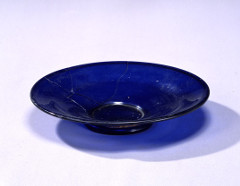 Photo courtesy of Tokyo National Museum
Photo courtesy of Tokyo National Museum
While much of the work done at RIKEN's SPring-8 synchrotron facility in Harima is in areas such as protein and new material analysis, it is also making contributions to archeological research. Researchers from the Tokyo University of Science recently used the facility to analyze a glass plate found in a tumulus in Nara dating back to the late 5th century.
Based on the analysis, using a non-destructive technique, they demonstrated for the first time that glass found in an ancient Japanese tumulus originated from the Roman Empire. They found that the glass is nearly identical to similar works originating during the Roman Empire, and the antimony found in the analysis performed at the SPring-8 facility indicated that it was similar to pieces that were made in Sassanid Persia until the second century AD.
Yoshinari Abe of Tokyo University of Science, who led the research, speculates that the piece may have been made in Rome, painted in Persia, and then transported along the Silk Road to finally arrive in Japan.
The piece is on display at the Tokyo National Museum until December 7.
